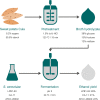The potential of sweet potato biorefinery and development of alternative uses
- PMID: 33619462
- PMCID: PMC7890384
- DOI: 10.1007/s42452-021-04369-y
The potential of sweet potato biorefinery and development of alternative uses
Abstract
The bioethanol production from the sweet potato variety BRS Cuia using three different strains of Saccharomyces cerevisiae (LPB1-93, ATCC-26602, and CA-11) was carried out in this research. Comparative analyses of consumed sugar, ethanol yield, and productivity (in tons per hectare) increased along with the concentration of cells in the inoculum. Additionally, to verify the aromatic quality of a potential sweet potato distilled spirit, volatile organic compounds were analyzed. The results showed a yield of over 90% ethanol. It was observed that the sugar consumption and ethanol production rates can be increased with a higher initial concentration of cells. This resulted in higher concentrations of ethanol in shorter times. From 100 g of the sweet potato variety BRS Cuia, the highest concentration of ethanol obtained was 25.74 g L-1 using the LPB1-93 strain. The estimated bioethanol production is about 10,000 L ha-1, with two sweet potatoes crops in a year. The ethanol production from the sweet potato variety BRS Cuia is viable, representing a sustainable alternative to fuel bioethanol, as well as an alcoholic beverage due to the volatile organic compounds present in the distilled fraction.
Keywords: Distilled sprit; Ethanol; Fermentation; Sweet potato.
© The Author(s) 2021.
Conflict of interest statement
Conflict of interestThe authors declare no conflict of interest.
Figures



Similar articles
-
Evaluation of sweet potato for fuel bioethanol production: hydrolysis and fermentation.Springerplus. 2013 Sep 30;2:493. doi: 10.1186/2193-1801-2-493. eCollection 2013. Springerplus. 2013. PMID: 24130960 Free PMC article.
-
Application of simultaneous saccharification and fermentation (SSF) from viscosity reducing of raw sweet potato for bioethanol production at laboratory, pilot and industrial scales.Bioresour Technol. 2011 Mar;102(6):4573-9. doi: 10.1016/j.biortech.2010.12.115. Epub 2011 Jan 6. Bioresour Technol. 2011. PMID: 21277777
-
Sugar and ethanol production potential of sweet potato (Ipomoea batatas) as an alternative energy feedstock: processing and physicochemical characterizations.Heliyon. 2021 Nov 15;7(11):e08402. doi: 10.1016/j.heliyon.2021.e08402. eCollection 2021 Nov. Heliyon. 2021. PMID: 34869926 Free PMC article.
-
Biorefinery of sweet sorghum stem.Biotechnol Adv. 2012 Jul-Aug;30(4):811-6. doi: 10.1016/j.biotechadv.2012.01.014. Epub 2012 Jan 28. Biotechnol Adv. 2012. PMID: 22306167 Review.
-
Potential impacts of bioprocessing of sweet potato: Review.Crit Rev Food Sci Nutr. 2017 Feb 11;57(3):455-471. doi: 10.1080/10408398.2014.960909. Crit Rev Food Sci Nutr. 2017. PMID: 25975980 Review.
Cited by
-
Utilization of Macroalgae for the Production of Bioactive Compounds and Bioprocesses Using Microbial Biotechnology.Microorganisms. 2023 Jun 5;11(6):1499. doi: 10.3390/microorganisms11061499. Microorganisms. 2023. PMID: 37375001 Free PMC article. Review.
References
-
- Sakai P, et al. Understanding the implications of alternative bioenergy crops to support smallholder farmers in Brazil. Sustainability. 2020;12:2146. doi: 10.3390/su12052146. - DOI
-
- FAOSTAT, Food and Agriculture Organization of United Nations, (2019). http://fao.org/faostat (accessed April 2, 2020)
-
- Akoetey W, Britain MM, Morawicki RO. Potential use of byproducts from cultivation and processing of sweet potatoes. Ciência Rural. 2017 doi: 10.1590/0103-8478cr20160610. - DOI
-
- Weber CT, Trierweiler LF, Casagrande T, Trierweiler JO. Economic evaluation of sweet potato distilled beverage produced by alternative route. Int J Dev Sustain. 2018;7(10):2514–2527.
LinkOut - more resources
Full Text Sources
Other Literature Sources
Molecular Biology Databases
Research Materials
